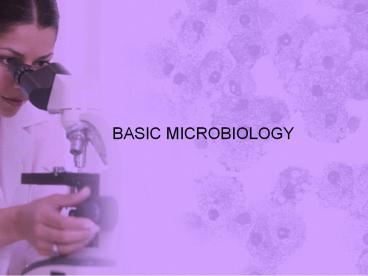BASIC MICROBIOLOGY - PowerPoint PPT Presentation
1 / 16
Title:
BASIC MICROBIOLOGY
Description:
... antifungal creams Athlete s Foot Related to dirty showers and running shoes Moist area between toes Thrush yeast infection Protists ... – PowerPoint PPT presentation
Number of Views:213
Avg rating:3.0/5.0
Title: BASIC MICROBIOLOGY
1
BASIC MICROBIOLOGY
2
Definition
- Microbiology is the science that studies living
organisms that cannot be seen with the naked eye
(microorganisms or microbes)
3
Nature of Microorganisms
- Most microorganisms are harmless, some are
beneficial and others harmful (pathogenic)
causing disease - eg. E. coli from the colon (breaks down
waste/makes vitamin K) can enter the urinary
tract and cause an infection
4
Types of Microorganisms
- Major types are
- Bacteria
- Fungi
- Protozoa (protists, parasites)
- Viruses
5
Transmission or Spread of Microorganisms
- Vectors usually an animal or insect that
carries the microorganism - Airborne - spread through the air by people's
coughing and sneezing - Direct contact - an infected person touching a
surface and then another person touching that
surface - Fecal-oral - contaminated hands, food and water
- Sexually Transmitted direct transfer of bodily
fluids (blood, semen)
6
Transmission or Spread of Microorganisms
7
Bacteria
- most familiar of the microbes that infect humans
- classified by their shape and arrangement
Type Shape Arrangement
Diplococci Round in pairs
Staphylococci Round in groups or clusters
Streptococci Round in chains
Bacilli Rod-shaped in pairs, single, or in chains
Spirilli Cork-screw or spiral single
8
(No Transcript)
9
Bacterial Resistance
- What is the proper way to take your antibiotics?
- Why are you not prescribed antiobiotics every
time that you have some type of flu or cold
symptoms? - What is MRSA?
- What are nosocomial infections?
10
Fungi
- Once classified as plants but they dont undergo
photosynthesis - Saprophytes feed on dead or decaying material
- Thrive in moist environments
- Examples (mould, mildew, yeast)
- Cause some diseases in humans
- Ringworm
- Athletes foot
- Thrush
- Poisonous
11
Ringworm
- Skin infection causing severe itching (scalp,
groin, beard) - If left untreated can be passed on to others by
direct or indirect contact, infected wrestling
mats - Treated with fungicides, antifungal creams
12
Athletes Foot
- Related to dirty showers and running shoes
- Moist area between toes
13
Thrush yeast infection
14
Protists (Protozoa)
- Also known as parasites
- Mostly unicellular
- Eukaryotes
- Thrive in moist environments
- Cause disease in humans
- Malaria
- Food poisoning
- Leishmaniasis
- Trypanosomiasis
15
Disease from Protists
- Malaria
- https//www.youtube.com/watch?vIVbq2yQH52g
- Food poisoning
- https//www.youtube.com/watch?vjlvXtvWm80A
- Leishmaniasis
- https//www.youtube.com/watch?vJR44Y0wUaX0
- Trypanosomiasis
- https//www.youtube.com/watch?v4aVUrGO97Zg
16
Viruses
- A virus is a microorganism that reproduces inside
the cells of living hosts - viruses attach to and enter the host cell and
force the cell into making more viruses - Viruses can cause diseases in humans (HIV, common
cold, Zika, Ebola) - Death of the host cell leads to symptoms
- Some viruses remain dormant in the body for long
periods without symptoms (herpes, chicken pox
virus) - Viruses are usually completely eliminated by a
healthy immune system, - Antibiotics have no effect on viruses,
- Vaccines that produce lifelong immunity can
prevent some viral infections.









![get [PDF] DOWNLOAD Medical Microbiology E-Book PowerPoint PPT Presentation](https://s3.amazonaws.com/images.powershow.com/10086233.th0.jpg?_=202407261011)

















![PDF Fundamentals of Microbiology: In-depth Introduction and Practical Guide [Print Replica] Kindle Edition Full PowerPoint PPT Presentation](https://s3.amazonaws.com/images.powershow.com/10077863.th0.jpg?_=20240712084)



